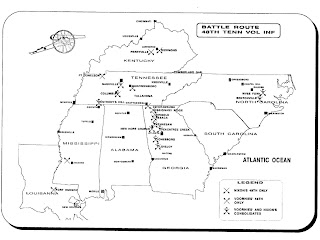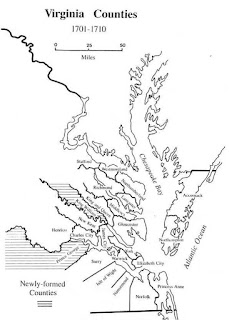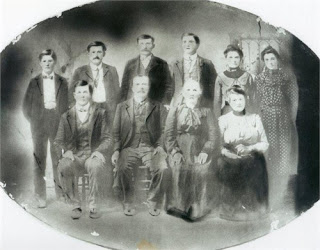Gilliams in the Civil War
When
he was interviewed in the 1990 documentary The Civil War, historian Shelby
Foote said this about the war:
Any understanding of this nation has to be based, and I mean really based, on an understanding of the Civil War. I believe that firmly. It defined us. The Revolution did what it did. Our involvement in European wars, beginning with the First World War, did what it did. But the Civil War defined us as what we are and it opened us to being what we became, good and bad things. And it is very necessary, if you are going to understand the American character in the twentieth century, to learn about this enormous catastrophe of the mid-nineteenth century. It was the crossroads of our being, and it was a hell of a crossroads.
The
war was also “a hell of a crossroads” for the descendants of Hinchea Gilliam
(1775-1858) and provides some insight into our ancestors' character. (Hinchea died before the War's start in 1861, but as the first common ancestor of the soldiers who fought in the war, he provides a convenient bookmark to catalog all the participants.)
Hinchea's son Joseph would die as a result of the war. Another son, Lemuel, was in uniform at age 50. No less than fourteen of Hinchea's grandsons would fight in the war, some Union, most Confederate, and two would die in action. An additional eight husbands of his grand-daughters fought in the war. After the war, it must have been a vibrant topic for discussions at family reunions, or perhaps prevented the reunions from occurring at all.
Hinchea's son Joseph would die as a result of the war. Another son, Lemuel, was in uniform at age 50. No less than fourteen of Hinchea's grandsons would fight in the war, some Union, most Confederate, and two would die in action. An additional eight husbands of his grand-daughters fought in the war. After the war, it must have been a vibrant topic for discussions at family reunions, or perhaps prevented the reunions from occurring at all.
At
the end of this post is a roster of Hinchea Gilliam’s sons, grand-sons and
husbands of grand-daughters who wore a Civil War uniform. Each merits his own
story, but a few require specific mention here:
CIVIL WAR
RECORD OF THOMAS JEFFERSON GILLIAM
Hinchea's
grandson (and son of Hardy Gilliam), Thomas Jefferson Gilliam, left Arkansas
and traveled to Columbia, Tennessee (located in Maury County, just south of
Nashville) where he enlisted as a Private in Company K, 48th Regiment
(Voorhies') Tennessee Infantry, CSA on October 12, 1861. This was just
three days after his 16th birthday, and only a few months after
Arkansas had seceded from the Union on May 6, 1861. We don’t know if he joined
with the blessings of his parents or whether he ran away to join the war (his
older brother, John Tillman Gilliam, enlisted two months later in December, 1861 at
age 20 in an Arkansas unit). Either way, it must have been quite the adventure for a 16-year-old.
A complete history of his unit and can be found in the book The Confederate Army, A Regiment: An
Analysis of The Forty-Eighth Tennessee Volunteer Infantry Regiment, 1861-1865,
by Major Gerald Kincaid. This map from that book may assist in following the unit's wartime travels:
The 48th
Tennessee Infantry was organized in October and November 1861 from Tennessee’s secessionist
middle counties: Hickman, Lewis, Maury, and Lawrence. In keeping with the citizenry
of the “Volunteer State”, the 48th was comprised of all volunteers
and not prompted by draft-avoidance (Tennessee did not start its draft until
April 1862). Thomas’ unit of the 48th, Company K, obtained its
soldiers from Maury County, Tennessee. The 48th elected W. M. Voorhies
as its commander.
After
it was organized, Voorhies’ 48th participated in the Confederate
invasion of Kentucky, in an attempt to get Kentucky to secede. The first
assignment of Company K was south of Bowling Green, Kentucky, where it was guarding
Whippoorwill Bridge. The first engagement of the larger 48th
was on 5 February 1862 at Forts Henry and Donelson. Company K had been left
behind, still guarding bridges, but joined the larger unit on 15 Feb 1862, at
the battle site at Fort Donelson, Kentucky. The unit fought well on the 15th,
but was routed the next day when Union forces led by US Grant captured 55
percent of the unit, including its commander, Colonel Voorhies. The battle
is considered to be a turning point in the war, as it prevented Kentucky from
leaving the Union and began Grant’s ascension to the top ranks of the Union
Army. More about the battle can be found here: https://en.wikipedia.org/wiki/Battle_of_Fort_Donelson
The
Confederates captured in that battle were sent to St. Louis and then Camp
Douglas in Chicago. Camp Douglas was the Union’s most notorious POW camp, often
referred to as “the North’s Andersonville.”
Thomas
and the other soldiers of the 48th that avoided capture joined
Johnston’s army at Corinth, Mississippi and were formed into a temporary
organization referred to as Sowell’s Detachment. The detachment was not healthy
enough to march when Johnston fought at Shiloh on April 6 and 7, 1862. Thereafter,
the remnants of the 48th returned to Corinth. Conditions in the camp
were miserable -- measles, typhoid, and dysentery were killing one soldier a
day.
The
48th reorganized at Corinth, Mississippi in April, 1862 under Col.
George M. Nixon with new equipment and drilling. Thomas was assigned to
Company C of Nixon’s 48th. The unit had a skirmish at Corinth in May,
1862, but abandoned Corinth to Union forces on 30 May. The 48th marched to
Baldwin, Mississippi, then Tupelo. On July 26, 1862, the unit was transported
by rail to Mobile, then to Montgomery, then to West Point, Georgia, then to
Atlanta and then Chattanooga, all in six days.
By August
6, 1862, the 48th was in Knoxville, and then to Barboursville,
Kentucky by August 12 by land march. The unit departed Barboursville August 21,
and arrived at Richmond, Kentucky on the 29th. The Battle of Richmond
began that day, which proved to be a Confederate victory. More detail can be
found here: https://en.wikipedia.org/wiki/Battle_of_Richmond
After
Richmond, the unit proceeded north through Lexington, Paris, and on to
Cynthiana, Kentucky. By, October 3, the unit was in Frankfort, then to Harrodsburg
and on to Perryville by October 7, 1862. The 48th participated in Battle
of Perryville on October 8, 1862. It was another costly Confederate defeat
and proved to be the decisive battle of the Kentucky campaign. More can be
found here: https://en.wikipedia.org/wiki/Battle_of_Perryville
After
the defeat in Kentucky, the unit retreated to Tennessee; first to Camp Dick Robinson,
then to Barboursville on October 18, and Knoxville by October 22, 1862. From
November 1862 to June 1863, the 48th remained in the vicinity of
Estell Springs, Tullahoma, Allisonia, Wartrace, and Shelbyville, Tennessee. On
June 30, 1863, the unit retreated further to Chattanooga, arriving on July 6.
The 48th
moved back and forth across the Tennessee-Georgia line several times over the next
two months, skirmishing with Union troops and guarding stretches of the
Tennessee River. In early September, the 48th was ordered from the
river and marched close to LaFayette, Georgia. The 48th engaged Union troops in
the Battle of Chickamauga on September 19, 1863, attacking at 4 pm that
afternoon. The Confederates inflicted heavy casualties, driving Union troops
back a mile and a half and capturing one of their cannons. The Confederates
planned to resume their attack early the next morning, but the orders came
late, permitting the Union to fortify its defenses. The late charge was met
with withering Union fire and the Confederates were forced to withdraw.
The
Confederates attacked again at 5 pm on September 20. This charge lasted nearly two
hours and the Confederates were finally able to get the upper hand, breaching
the Union defenses, and capturing Union men and equipment. Unfortunately, the victory at Chickamauga cost
the 48th over 50 percent dead and wounded. More about Chickamauga
can be found here: https://en.wikipedia.org/wiki/Battle_of_Chickamauga
After Chickamauga, Nixon’s 48th never
recovered. Its remaining troops formed a sharpshooter battalion and joined Polk’s
brigade during the Atlanta campaign. They engaged at Resaca on May 16, 1864 and
the Battle of Kennesaw Mountain on June 27. The brigade disbanded on July 15,
1864 and the remaining men in Nixon’s 48th were transferred to
Voorhies’ 48th. The 48th finally
surrendered in the spring of 1865 in North Carolina.
The day-to-day unit rolls are not online, so we
don’t know if Thomas fought with the 48th in all the battles the
unit participated in during the war. Throughout the war, the 48th
suffered a high desertion rate every time it pulled up stakes and moved out of
Tennessee. Apparently, many of its men believed they were fighting to defend
their home state and simply went home when the unit retreated or otherwise maneuvered
out of Tennessee. When the 48th would return to the state, some of
the deserters would rejoin the unit. If Thomas indeed remained with 48th and did not go absent without leave, he would have been only one of the 60 men who lasted in the
unit throughout war. Nearly 2,850 men served in the 48th
Regiment, Tennessee Infantry, CSA, from its inception until its surrender.
On April
24, 1865, Thomas signed his Oath of Allegiance to the US in Chattanooga,
Tennessee, fifteen days after Lee’s surrender at Appomattox. After the war, he
returned to Arkansas and married Martha Fallen.
We have the following “official” record of his service:
We have the following “official” record of his service:
DEATHS IN CAPTIVITY
At age 55, Hinchea’s
son Joseph Gilliam (1805-1862) would have been too old at the outbreak of the
war to fight. But according to Goodspeed’s
Compendium of Biography, Joseph was arrested by Union officers due to his sympathy for the "Southern cause." He was taken to Chattanooga and was in
the process of being transferred to Shelbyville when he died enroute in June, 1862.
We do not know whether his death was caused by accident, sickness, or foul play.
Isham H. Gilliam, was the son of Hinchea's son William and fought in the Missouri 16th Infantry Regiment, CSA. He was captured and died of an infection while a prisoner of war. He is buried in the Jefferson Barracks Veteran's Cemetery in St. Louis
Isham H. Gilliam, was the son of Hinchea's son William and fought in the Missouri 16th Infantry Regiment, CSA. He was captured and died of an infection while a prisoner of war. He is buried in the Jefferson Barracks Veteran's Cemetery in St. Louis
KILLED IN ACTION
Brothers
James Matthew Gilliam and John H. Gilliam were the sons of Hinchea's son
Thomas. Both were Privates in Co. F, 5th Tennessee Cavalry, a unit in the Union Army. In July, 1864,
their unit was holding ground in Tracy City, Tennessee. The unit's mission was
to protect local bridges from being burned by marauding bands of Confederates.
They were only a short horseback ride from the family home on Battle Creek in
Marion County, and the brothers obtained leave to make a short family visit. At the conclusion of their leave, they were headed back to their unit on their family horses. They had a traveling companion whose role was to return the horses after the brothers reunited with
their unit. According to The Story of Marion County Its
People and Places,
James and John were “killed by Confederate bushwhackers near Tracy City on 2
August 1864.” According to family history, the companion was blinded by the
ambush and left for dead. After the Confederates left the area, he made his way
down the mountain and summoned assistance. One of the brothers was engaged to
be married to Comfort Tate and she helped organize a recovery party to retrieve the
bodies. The brothers are buried in the Tate Cemetery near Martin Springs, in
Marion County.
THE
GILLIAM CIVIL WAR ROSTER
Sons of Hinchea Gilliam
Lemuel Gilliam, 60th Regt., Tennessee Mounted Infantry (Crawford's) 79th Infantry, CSA
Sons/Sons-in-law of John A. Gilliam
James M. Johnson (husband of daughter Sarah), 38th Regt., Tennessee Infantry (Looney's), 8th Infantry, CSA
Elijah A. Fletcher (husband of daughter Nancy), 11th State Militia, Union Army
Lemuel Gilliam, 60th Regt., Tennessee Mounted Infantry (Crawford's) 79th Infantry, CSA
Sons/Sons-in-law of John A. Gilliam
James M. Johnson (husband of daughter Sarah), 38th Regt., Tennessee Infantry (Looney's), 8th Infantry, CSA
Elijah A. Fletcher (husband of daughter Nancy), 11th State Militia, Union Army
Sons/Sons-in-law
of William A. Gilliam
Isham H. Gilliam, Missouri 16th Infantry Regt., CSA. He was captured and died of an infection while a POW. Buried in the Veteran's Cemetery in St. Louis.
Henry Gilliam, 17th Regt., Tennessee Infantry, CSA
Joseph S. H. Gilliam, Brevet 2nd Lieutenant, Co. A, Tennessee 32nd Infantry Regt., CSA.
Henry J. Barnes (husband of daughter Nancy Sarah), 44th Cons. Regt., Tennessee Infantry, CSA
Charles Ross (husband of daughter Mary Ann) CSA
Isham H. Gilliam, Missouri 16th Infantry Regt., CSA. He was captured and died of an infection while a POW. Buried in the Veteran's Cemetery in St. Louis.
Henry Gilliam, 17th Regt., Tennessee Infantry, CSA
Joseph S. H. Gilliam, Brevet 2nd Lieutenant, Co. A, Tennessee 32nd Infantry Regt., CSA.
Henry J. Barnes (husband of daughter Nancy Sarah), 44th Cons. Regt., Tennessee Infantry, CSA
Charles Ross (husband of daughter Mary Ann) CSA
Sons
of Isham Gilliam
No record of Civil War involvement
No record of Civil War involvement
Sons
of Joseph Gilliam
Samuel Newton Gilliam, Tennessee 34th Regt., 4th Infantry, CSA
Thomas Wesley Clepper (husband of daughter Mary Jane), Tennessee 34th Regt., 4th Infantry, CSA
Samuel Newton Gilliam, Tennessee 34th Regt., 4th Infantry, CSA
Thomas Wesley Clepper (husband of daughter Mary Jane), Tennessee 34th Regt., 4th Infantry, CSA
Sons of Thomas Gilliam
James Matthew Gilliam, Co. F, 5th Tennessee Cavalry, Union Army
John H. Gilliam, Co. F, 5th Tennessee Cavalry, Union Army
William Francis Gilliam, Co. F, 5th Tennessee Cavalry, Union Army. Taken prisoner on 2 Dec 1864 in Hillsboro, Tennessee.
Spencer Wiley Gilliam, Co. C, 6th Tennessee Mounted Infantry, Union Army
Henry Lafayette Bible (husband of daughter Alzina), Co. F, 5th Tennessee Cavalry, Union Army
Sons
of Lemuel Gilliam
J. Wiley Gilliam, 20th Infantry Regt. (Elmore's), CSA
J. Wiley Gilliam, 20th Infantry Regt. (Elmore's), CSA
Sons of Frances Gilliam Tyra
Elisha H. Tyra, 32nd Regt., Mississippi Infantry, CSA
Jesse V. Tyra, Co. G, Alabama 8th Cavalry Regt., CSA. According to family lore, he was a Union sympathizer and deserted at his first opportunity. He moved his family to Illinois for the duration of the war.
William M. Frederick (husband of daughter Ermand Adaline), 3rd Ohio, Union Army
Elisha H. Tyra, 32nd Regt., Mississippi Infantry, CSA
Jesse V. Tyra, Co. G, Alabama 8th Cavalry Regt., CSA. According to family lore, he was a Union sympathizer and deserted at his first opportunity. He moved his family to Illinois for the duration of the war.
William M. Frederick (husband of daughter Ermand Adaline), 3rd Ohio, Union Army
Sons/Sons-in-law of Mary Gilliam Melton
T.C. Jenkins, (husband of daughter Martha) Co. H, 55th Alabama, CSA
Sons of Wiley Blount Gilliam
No record of Civil War involvement.
T.C. Jenkins, (husband of daughter Martha) Co. H, 55th Alabama, CSA
Sons of Wiley Blount Gilliam
No record of Civil War involvement.
Sons of Hardy Gilliam
John Tillman Gilliam. Enlisted in December 1861 at age 20, captured at siege of Vicksburg, later exchanged and returned to service, served until war's end. Co. C, 1st Arkansas Cavalry (Stirman's), CSA
Thomas Jefferson Gilliam, enlisted October, 1861 at age 16. Co. C, 48th Regt. (Nixon's) Tennessee Infantry, CSA
John Tillman Gilliam. Enlisted in December 1861 at age 20, captured at siege of Vicksburg, later exchanged and returned to service, served until war's end. Co. C, 1st Arkansas Cavalry (Stirman's), CSA
Thomas Jefferson Gilliam, enlisted October, 1861 at age 16. Co. C, 48th Regt. (Nixon's) Tennessee Infantry, CSA
Sons of Elizabeth Jane Gilliam Ferguson
William Webb Ferguson, 14th Regt., Arkansas Infantry, CSA
William Webb Ferguson, 14th Regt., Arkansas Infantry, CSA
Extended
In-Laws
Rees Hildreth (father of Maggie Hildreth Gilliam and Annie Hildreth Gilliam), enlisted 1864 at age 18, Co. C, 27th Regt., Missouri Infantry, Union Army
Rees Hildreth (father of Maggie Hildreth Gilliam and Annie Hildreth Gilliam), enlisted 1864 at age 18, Co. C, 27th Regt., Missouri Infantry, Union Army





Comments
Post a Comment